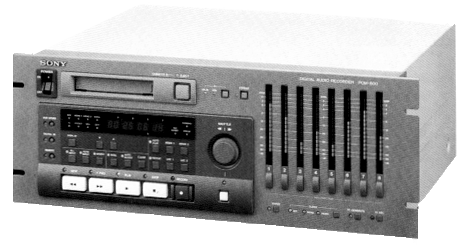
by Jerry Vigil
In the world of digital multi-tracking, two tape-based systems have gained wide acceptance. First came the ADAT which records to S-VHS video tape. Alesis and Fostex offer the machines for this format. Then came the DTRS (Digital Tape Recording System) format, introduced with the Tascam DA-88, which records to Hi-8mm video tape. Late last year, Sony entered the Hi-8 format with the PCM-800. Both formats provide eight digital tracks with up to one hour of recording time on S-VHS format and nearly two hours on the Hi-8mm tapes.
The PCM-800 is essentially identical to the DA-88 with most differences appearing on the rear panel, and Sony opted for a dark grey front panel as opposed to Tascam's beige. Unlike the DA-88, the PCM-800 provides balanced XLR analog inputs and outputs (unbalanced RCA on the DA-88), and the PCM-800 offers AES/EBU digital I/O via two D-sub 25-pin connectors. Other rear panel connectors include the Meter Unit 15-pin connector to drive external metering. The Remote In/Sync In D-sub 15-pin connector is where the optional RM-D800 remote control is connected, and it is also used (along with the Sync Out connector) to hook up multiple PCM-800s. Up to sixteen PCM-800s can be hooked together to provide up to 128 tracks. There are Word Sync I/O connectors and a remote Punch In/Out jack for a footswitch. The Machine ID rotary switch assigns an ID number to the machine and is used when two or more PCM-800s are synchronized. Four red LED Error Indicators light when the sampling frequency and emphasis settings of digital input signals don't match the settings on the PCM-800, or when there is no signal at the digital input. Finally, next to the AC power connector, a large heat sink occupies about one-third of the back panel. The optional DABK-801 Sync board fits into an empty slot on the back panel and provides SMPTE/EBU time code synchronization, a time code generator, MIDI machine control, and NTSC/PAL video synchronization.
The front panel tour begins with the Power On/Off switch at the top left adjacent to the tape loading door and EJECT button. The small Hi-8mm tapes are about the size of a cassette and a little thicker. Upon insertion, the PCM-800 grabs the tape and loads it, closing the door behind. As it's doing this, the orange LED time display below reads "LOAD" then displays the current absolute tape time in hours, minutes, seconds, and frames, assuming the tape has been formatted. Formatting is a real-time process and must be done before any recording can occur. Sony's DARS-116 tape, designed for digital audio recording, provides 116 minutes of recording time and takes 116 minutes to format. Press the FORMAT key to engage the format mode, then press the Fs key to select the sampling frequency, 44.1kHz or 48kHz.
The transport controls are very large. You get REW, FFWD, PLAY, STOP, and RECORD. To the right of these are the SHUTTLE button and dial. Pushing the button activates the shuttle function. Turning the dial in either direction plays back the tape at variable rates between ¼ normal speed and 8 times normal speed. This is handy for locating precise points on the tape, but this does not function as a way to cue up to a point for "instant start." This function is most handy for identifying punch in/out points, and it is more responsive than using the REW and FFWD buttons to maneuver within a small section of tape.
There are eight LED peak level meters on the right side of the front panel. Below each is a REC FUNCTION key and red LED indicator. Pressing the REC FUNCTION key puts the track in Record Ready mode, the red LED flashes, and that track's monitoring is set to the input signal. When recording, the LED remains lit. Below the meters are controls and indicators for time code and synchronization functions.
